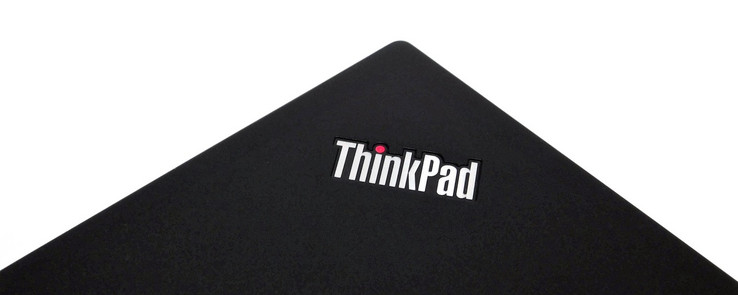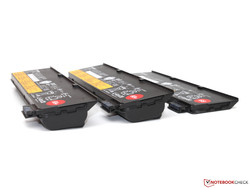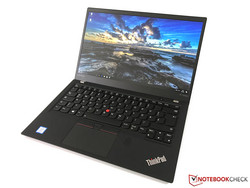Lenovo ThinkPad T & X - Which is the best mobile ThinkPad notebook?
For the original German review, see here.
You would think that more choice is better than less, but too much choice can be confusing and buyers are often overwhelmed by the various models and configurations that are available on the market today. Many potential buyers seek professional advice, for example, in various online forums. In our first buyer’s guide, we will take a look at a manufacturer that has a rather complex PC lineup, which is not always easy to see though. We are talking about Lenovo. As it would be too much to try to tackle the whole range of mobile Lenovo laptops in one article, we will focus only on the T and X series ThinkPads. The title already mentions that we are most interested in mobility. We will be talking about performance and connectivity in a separate article.
This article is not a simple summary of the individual reviews. Instead, we want to focus on the biggest differences in terms of mobile use between the laptops. Therefore, we will not be talking about the quality of the keyboard or other input devices, as they are of similar high quality for all ThinkPads. The same can be said for the quality of the case. Please take a look at our detailed individual reviews for possible alternatives from other manufacturers.
By now, we have advanced relatively far into the model cycle of the Kaby-Lake generation, and we have tested almost all models of the T and X series, with the exception of the T470p which is currently being tested. This means that at the time of publishing there are no results for this model. Reviews are available for all other models: The T470, the T570 (incl. 4K update), the T470s, the X1 Carbon as well as the X270.
Lenovo ThinkPad Charts
Rank | Date | Rating | Image | Model / Review | Height | Weight | Size | Resolution | Screen | Price |
|---|---|---|---|---|---|---|---|---|---|---|
| 1 | 02 / 2017 | 90.8 % v6 (old) | Lenovo ThinkPad T470-20HD002HGE Intel Core i5-7200U ⎘ Intel HD Graphics 620 ⎘ 8 GB Memory, 512 GB SSD | 19.95 mm | 1.7 kg | 14.00" | 1920x1080 | matte | ||
| 2 | 03 / 2017 | 90.4 % v6 (old) | Lenovo ThinkPad X1 Carbon 2017-20HQS03P00 Intel Core i7-7500U ⎘ Intel HD Graphics 620 ⎘ 16 GB Memory, 512 GB SSD | 15.95 mm | 1.1 kg | 14.00" | 1920x1080 | matte | ||
| 3 | 05 / 2017 | 87.4 % v6 (old) | Lenovo ThinkPad T470s-20HGS00V00 Intel Core i7-7600U ⎘ Intel HD Graphics 620 ⎘ 16 GB Memory, 1024 GB SSD | 18.8 mm | 1.4 kg | 14.00" | 2560x1440 | matte | ||
| 4 | 04 / 2017 | 86.4 % v6 (old) | Lenovo ThinkPad T570-20H90002GE Intel Core i5-7200U ⎘ Intel HD Graphics 620 ⎘ 8 GB Memory, 256 GB SSD | 20.2 mm | 2 kg | 15.60" | 1920x1080 | matte | ||
| 5 | 04 / 2017 | 85.4 % v6 (old) | Lenovo ThinkPad X270-20HMS00T00 Intel Core i5-7200U ⎘ Intel HD Graphics 620 ⎘ 8 GB Memory, 512 GB SSD | 20.3 mm | 1.4 kg | 12.50" | 1920x1080 | matte | ||
| 6 | 06 / 2017 | 88.4 % v6 (old) | Lenovo ThinkPad T470p-20J7S00000 Intel Core i7-7700HQ ⎘ NVIDIA GeForce 940MX ⎘ 8 GB Memory, 512 GB SSD | 24.4 mm | 1.9 kg | 14.00" | 2560x1440 | matte |
Size and Weight: Light or Small
Talking about mobility, some of the most important factors include the device's size, weight and battery runtime - but also things such as screen brightness. The X series traditionally is the ThinkPad series that is most suited to mobile use. Lenovo offers two sizes for this series: the X270 at 12.5 inches and the X1 Carbon at 14 inches. Although we have to say that the X1 Carbon with its thin bezels looks more like a classic 13.3-inch notebook. The X270 is significantly more compact, but the screen size-to-bezel ratio is a lot worse. The X270 is the most compact device of all comparison devices, but it is a lot thicker and heavier than the X1 Carbon.
Tied in the size: The X1 Carbon is a little larger than the X270, but a lot lighter and slimmer.
The light-weight X1 Carbon is only just beaten by the T470s, the lightest and most compact model of the T series. The other T-models show more weight on the scales, but the T470 and the T570 are noticeably lighter and partly slimmer and more compact than their predecessors. The T470p, however, is almost as heavy as the T570 and its standard battery is very thick. This is probably the device which is the least comfortable to handle; although the T570 is bigger, it is a lot slimmer.
Price Comparison Lenovo ThinkPad X270
Price comparison
Price Comparison Lenovo ThinkPad X1 Carbon 2017
Price comparison
Power Consumption: Optimization beats Configuration
So there was no clear winner in the category size and weight. The X270 and the X1 Carbon are on a par and the T470s made third place. But what is the use of a compact, light case if the device cannot survive for long without being connected to a power supply? Not much, an ultra-mobile laptop has to have convincing battery runtime as well. This is influenced by power consumption and battery capacity.
Several factors play a role in power consumption: CPU, GPU, display size and resolution are the main contributors. Most processors require a similar amount of power in all our comparison devices, with the exception of the T470p. This model is equipped with quad-core processors that are a lot faster during multi-core performance, but consequently consume more power. The T470p's GPU falls out of line as well. As with the T570 it can be optionally fitted with an Nvidia GeForce 940MX. The dedicated GPU affects battery consumption only slightly while idling, but consumes a considerable amount under load. This leaves only the display: four out of the six compared ThinkPads have 14-inch screens; one has a 15.6-inch screen and the other a 12.5-inch screen. Generally, the rule of thumb is: the bigger the display and the higher the resolution, the higher the power consumption.
To consume the least power, it might be worth choosing a less powerful CPU configuration and going without a dGPU and 2K/4K display. However, the latter could also be a disadvantage in some situations, which we will talk about in the section about screen brightness below.
But in the end, the proper use of the system also has a big influence on a device's power consumption in practice. Under load the T470p and the T570 with 4K and dGPU are the models that consume the most power, but that was to be expected due to their powerful components. It becomes a lot more interesting when we take a look at the power consumption results while idling. Here, the T470s and the T570 with 4K display do a rather bad job. Perhaps that is due to insufficient optimization, but at least for the T570, the 4K display is probably a big contributor. The T470 is the most energy-efficient.
| Lenovo ThinkPad T470-20HD002HGE i5-7200U, HD Graphics 620, 14", 1920x1080 | Lenovo ThinkPad T470s-20HGS00V00 i7-7600U, HD Graphics 620, 14", 2560x1440 | Lenovo ThinkPad T470p-20J7S00000 i7-7700HQ, GeForce 940MX, 14", 2560x1440 | Lenovo ThinkPad T570-20H90002GE i5-7200U, HD Graphics 620, 15.6", 1920x1080 | Lenovo ThinkPad T570-20HAS01E00 i7-7500U, GeForce 940MX, 15.6", 3840x2160 | Lenovo ThinkPad X1 Carbon 2017-20HQS03P00 i7-7500U, HD Graphics 620, 14", 1920x1080 | Lenovo ThinkPad X270-20HMS00T00 i5-7200U, HD Graphics 620, 12.5", 1920x1080 | |
|---|---|---|---|---|---|---|---|
| Power Consumption | |||||||
| Idle Minimum * (Watt) | 3.21 | 4.64 | 3.8 | 3.6 | 4.7 | 3.84 | 3.5 |
| Idle Average * (Watt) | 6.15 | 8.93 | 6.5 | 7.7 | 9.9 | 6.3 | 5.8 |
| Idle Maximum * (Watt) | 6.82 | 9.12 | 7.2 | 8.2 | 10.9 | 8.6 | 7.6 |
| Load Average * (Watt) | 28.5 | 42.2 | 62.5 | 30.8 | 56.1 | 41.9 | 33.2 |
| Load Maximum * (Watt) | 34.5 | 47.3 | 99.6 | 46.1 | 75 | 48.7 | 40.4 |
* ... smaller is better
Price Comparison Lenovo ThinkPad T470
Price comparison
Battery Performance: PowerBridge vs. RapidCharge
In terms of the battery, there is one big difference between the various models: The X1 Carbon and the T470s have only internal batteries that cannot be expanded or exchanged on the go. The X270, the T470 and the T570 are equipped both with an internal and an external, exchangeable battery, that can even be exchanged for a larger battery. Lenovo calls this a "PowerBridge". The T470p is different again. This device has got only an external and no internal battery.
The largest ThinkPad also provides the highest battery capacity in our comparison. If you equip the device with the large external 72 Wh battery, it can reach a maximum capacity of 105 Wh. The X270 and the T470 each provide a maximum of 95 Wh, the T470p can offer 72 Wh of battery capacity. Compared to its predecessor, the X1 Carbon's battery has been enlarged to 57 Wh; the T470s can only reach a maximum capacity of 51 Wh, which is the lowest of all comparison devices. This could have something to do with the peculiar build of the two internal batteries.
A difficult decision: The PowerBridge ThinkPads offer great flexibility, but in exchange for good battery runtime, you need to accept more weight and longer charging times. The X1 Carbon offers a long battery life in its standard configuration and a battery that recharges quickly.
This feature combined with its compact size, could make you think that the X270 would easily make first place in the category mobility. But be aware that the large battery does add additional weight to the device. Our test unit of the X270, as well as those of the other models with PowerBridge, were all configured with the smaller battery and a battery capacity of 48 Wh. With this configuration, the device offered a disappointing performance - even its own predecessor did better. The X1 Carbon is different: It offers a maximum capacity of "only" 57 Wh, but Lenovo really makes use of the available capacity and has noticeably better battery runtimes. The T470p reached the best results, but it should be noted that our test unit was equipped with the largest battery with 72 Wh. Many available T470p models are equipped with the smaller 48 Wh battery ex-works, which we tested in the predecessor T460p.
Should you find a socket when you are out and about, it is helpful to have a quick-charge function included. Out of all the ThinkPads we compared, only the X1 Carbon is equipped with this function, which Lenovo calls "RapidCharge". The other ThinkPads’ charging times are significantly longer. This is partly due to the PowerBridge which means up to a 3-hour wait until both batteries are fully charged.
Price Comparison Lenovo ThinkPad T470p
Price comparison
Price Comparison Lenovo ThinkPad X1 Carbon 2017
Price comparison
Screen Brightness: the Sharper, the Brighter
Using a device while you are out and about, you sometimes cannot avoid having to work in bright surroundings with direct or indirect sunlight. Luckily, all compared ThinkPads are equipped with a matte screen, but they also need to offer enough screen brightness for the image to be visible outside. All tested ThinkPads exceed 200 cd/m², which is the minimum for comfortable working in the shade.
Not all devices reach 300 cd/m² despite Lenovo citing this value in the specifications for all models. The only exception is the T470, which only has display options of up to 250 cd/m² available. Curiously, the full HD IPS panel that our test unit is equipped with reaches 280 cd/m², which is higher than specified. In direct contrast to that, the T470p, the X270 and the X1 Carbon reach only 280 to 290 cd/m² on average despite the specifications stating 300 cd/m². The 14-inch QHD display of the T470p has a mere 265 cd/m². Unfortunately, it seems as if Lenovo continues to use varying display panels with variable degrees of screen brightness. This means that two devices of the exact same model can have different brightness levels.
In theory, the higher the screen resolution, the higher the brightness will tend to be. But due to this display lottery, there is no guarantee that you will get a bright display.
The 2K and 4K displays that the T470s and T570 are equipped with are the brightest with an average brightness of over 310 cd/m². However, you can only be sure to get exactly this 4K display with the T570 - all other models have various panels from different manufacturers.
Price Comparison Lenovo ThinkPad T470s
Price comparison
Price Comparison Lenovo ThinkPad T570
Price comparison
Temperatures: Keeping a cool Base Unit
As you do not always have a table available when working on the move, sometimes you will probably resort to using your laptop as a real laptop - on your lap. In order for that to be a comfortable option, the bottom of the base unit needs to remain relatively cool - in the best case not just while idle, but under load, too. The temperature limit here is at about 50 °C (~122 °F). Above that, using the device on your lap becomes quite uncomfortable after a while.
The T470 remains the coolest device. The T470s, the X1 Carbon and the T570 (iGPU) all have similarly good results (the T560 model with GeForce GPU heats up a lot more). The T470p crosses the 50 °C (~122 °F) limit, but then again it contains the strongest components. The X270 becomes surprisingly hot. It reaches temperatures of around 60 °C (~140 °F), which is noticeably higher than any other comparison device. At this temperature - which we have already measured with the i5-7200U version - the device cannot be used on the lap while working under load.
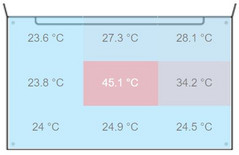
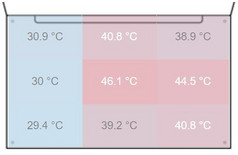
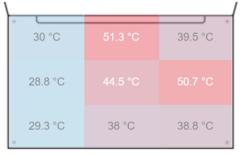
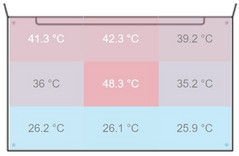
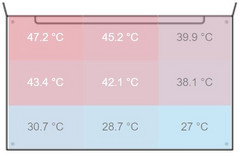
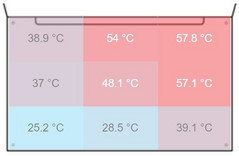
Price Comparison Lenovo ThinkPad T470s
Price comparison
Price Comparison Lenovo ThinkPad T470
Price comparison
Verdict
There really is no single winner that is best suited for all users in this comparison category. After all, which device is the best depends on everyone's personal needs. The X1 Carbon 2017 is definitely the best all-round model of all our comparison devices and, for most users, should prove the best choice for mobile use among ThinkPads. It is relatively compact and the lightest device of all compared models. It has a long battery runtime and a battery that recharges quickly. At the same time, it remains cool enough for use on the lap despite its slimness, and at least its display is bright enough to work in the shade.
The T470, the T570 and the X270 have the advantage of the PowerBridge battery system. This can provide users with very long battery runtimes, but also means more weight and long charging times. Of course the difference between these three models is the screen size. Users can decide how large their display should be for comfortable use, or rather how much weight they are willing to carry around. The X270 is the most compact device, but has some disadvantages in terms of battery runtime and temperatures. The T470 is a good compromise in terms of screen size, but it only nominally offers 250 cd/m³ screen brightness with varying results in practice. The T570 can be configured with the best display of all the comparison devices, but it is also the largest model and the display consumes a lot of power, which shortens the battery runtime.
The ThinkPad X2 Carbon is probably the best option among the T and X series ThinkPads for most users, which makes it the winner of this comparison. But if somebody needs higher flexibility, the other ThinkPads could be the better option for them.
The remaining two models - T470p and T470s fall behind a little in this comparison. The T470p would be more suited for stationary use. It is just as heavy as the larger T570 and the thickest device. Due to the quad-core processor, it also comes with the heaviest and largest power supply. It did get the best results in the battery test, but it was also the only model equipped with an additional large 72 Wh battery ex-works. The T470s on the other hand was supposed to be the most mobile ThinkPad of the T series, but was made superfluous by the X1 Carbon. It does have some features that could make it an interesting choice for companies, but its suitability for mobile use is weakened by its battery runtime. It also lacks the X1 Carbon's quick-charge function due to the two internal batteries. In terms of size, the X1 Carbon is a bit smaller, which leaves the T470s in a slightly awkward position between the X1 Carbon and the T470.


